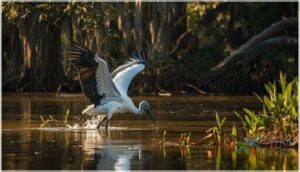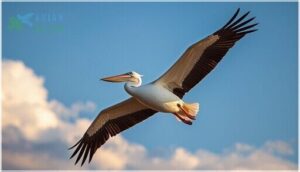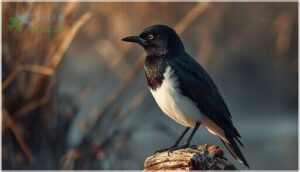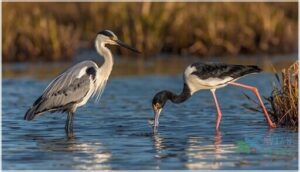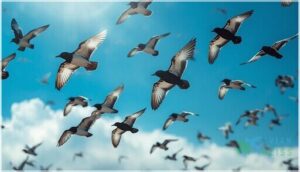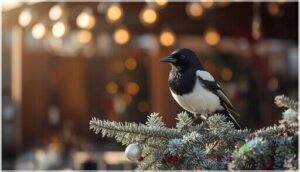This site is supported by our readers. We may earn a commission, at no cost to you, if you purchase through links.

From the massive wingspan of American White Pelicans to the distinctive hunting style of Black Skimmers, these birds have evolved their contrasting colors for reasons that go far beyond looking good. Their plumage has critical functions in everything from thermoregulation to predator avoidance.
Whether you’re watching them soar overhead or wade through shallow waters, understanding what makes these species unique will transform your next birdwatching adventure into something truly memorable.
Table Of Contents
- Key Takeaways
- What Are Medium-Sized Black and White Birds?
- Common Medium-Sized Black and White Birds
- Large White Birds With Black Under Wings
- Notable Large White Birds With Unique Markings
- Identifying Big Black Birds With White Bellies
- Noteworthy Big Black Birds With White Markings
- Black and White Plumage in Water Birds
- Social Behavior of Black and White Birds
- Flight Patterns of Black and White Birds
- Holiday Market Event With Black and White Bird Theme
- Frequently Asked Questions (FAQs)
- What is a black and white bird?
- What birds have black and white feathers?
- What birds live in North America?
- How many types of birds are black and white?
- What does a white bird look like?
- What is a black waterbird with white dots?
- What is a medium sized black and white bird?
- What is a black and white crow like bird?
- What is a large white bird with black under its wings?
- What is a big black bird with a white belly?
- Conclusion
Key Takeaways
- Large black and white birds use their contrasting plumage for practical survival functions like thermoregulation, predator avoidance, and species recognition during flight coordination, not just visual appeal.
- Many black and white species demonstrate specialized adaptations tied to their habitats—American White Pelicans cooperatively herd fish with 9-foot wingspans, while Black Skimmers use uniquely elongated lower bills to slice through water at dawn and dusk.
- Several prominent black and white bird populations face significant conservation challenges, including Snow Geese (75% decline since 2007), Black Skimmers (87% decline since 1966), and Dark-eyed Juncos (declining 1.5-2% annually despite 630 million individuals).
- Social behaviors among black and white birds vary dramatically by species—Wood Storks and American White Pelicans excel at colonial teamwork and parental investment, while Black-billed Cuckoos show nomadic tendencies with less than 20% returning to previous breeding sites.
What Are Medium-Sized Black and White Birds?
What makes some birds stand out like they’re wearing a formal tuxedo? Medium-sized black and white birds are a fascinating bunch, each sporting distinctive markings that make identification easier than you’d think. These striking species range from the tree-hugging Black-and-white Warbler to the bold Black-billed Magpie of open country, all thriving across diverse North American habitats.
Their contrasting plumage variations aren’t just eye candy. These bold patterns serve real purposes in camouflage and communication, helping birds like the White-breasted Nuthatch blend into bark while foraging. You’ll notice habitat preferences vary widely—some prefer dense forests while others stick to woodland edges.
Diet diversity among black and white bird species is impressive too. Many hunt insects along tree trunks, supporting natural pest control in forest ecosystems. As insectivores, they sport thin, pointed bills, a trait shared with many warbler species. While identifying black and white birds, consider their conservation status—some populations face challenges from habitat loss. Understanding these medium-sized marvels helps you become their advocate in protecting regional differences and maintaining healthy bird populations.
Common Medium-Sized Black and White Birds
You’ll find some truly striking birds in the medium-sized category that sport striking black and white patterns. These species range from wading birds with impressive wingspans to woodland dwellers that tap away at tree trunks.
Let’s look at four standout examples you’re likely to encounter in various habitats across North America.
Wood Stork
You’ll recognize wood storks by their white bodies and distinctive black flight feathers. These wading birds thrive in shallow wetlands, using a unique touch-based foraging behavior to snag fish in murky water.
Their breeding habits center on cypress swamps and mangroves, where pairs raise two to five chicks annually. Thanks to focused stork conservation efforts, population trends have rebounded from endangered status, though protecting their habitat remains essential for survival.
The Spring Island Trust actively works to manage rookery habitat to support wood stork nesting.
Hairy Woodpecker
If you’re shifting from wetlands to woodlands, the Hairy Woodpecker is your next black and white bird to master. You’ll spot this medium-sized beauty hammering away on mature trees with its long, chisel-like bill. Woodpecker identification gets easier when you notice:
- Distinctive drumming rhythm on dead snags
- White stripe down the black back
- Diet diversity—75% insects, plus seeds at your feeder
- Nesting habits in excavated cavities up to 60 meters high
Their conservation status looks solid, with populations up 54% since 1970. Despite habitat loss concerns in fragmented forests, these adaptable woodpeckers thrive across regional variations from Alaska to Panama.
Dark-eyed Junco
You’ll spot the Dark-eyed Junco hopping around winter feeders, a compact gray-and-white bird with slate upperparts and a crisp white belly. With a massive population of 630 million individuals, they’re everywhere during colder months. Their habitat shifts from high-elevation conifer forests in summer to suburban yards in winter. The Junco’s diet consists mostly of seeds—about 75% year-round—though they’ll grab insects during the breeding season.
| Characteristic | Details |
|---|---|
| Junco Migration | Northern breeders migrate south September-November; males winter farther north |
| Junco Reproduction | 3-6 eggs per clutch; 12-13 day incubation; ground nests under vegetation |
| Population Trend | Declining 1.5-2.0% annually since 1966 despite large overall numbers |
| Winter Foraging | Scratches through leaf litter and snow for grass and weed seeds |
During winter, Juncos forage by scratching through leaf litter and snow in search of grass and weed seeds. Despite their large overall numbers, the population has been declining at a rate of 1.5-2.0% annually since 1966.
Bobolink
During breeding season, male Bobolinks flip the script with their striking reverse-tuxedo plumage—creamy nape and back against black underparts. These notable songbirds undertake 20,000 km annual migrations between North American grasslands and South America.
You’ll recognize breeding males by their bubbling, metallic songs as they establish territories in hayfields and prairies. Despite their current 10 million strong numbers, population decline threatens their future.
Large White Birds With Black Under Wings
When you look up and see a massive white bird gliding overhead with contrasting black underwings, you’re witnessing one of nature’s most striking designs. These large birds use their black and white plumage strategically—the melanin-rich black wing tips resist wear during long migrations, while the white body reflects heat and helps with soaring efficiency.
American White Pelicans showcase this perfectly with their impressive 8–10 foot wingspan, displaying bold black flight feathers against snowy plumage. White Storks follow similar patterns, traveling up to 10,000 kilometers between Europe and Africa. The black underwings aren’t just for show—they boost visibility for species recognition during flocking behavior and coordinate group takeoff.
Snow Geese demonstrate this adaptation brilliantly too, with their 135–165 cm wingspan featuring distinctive black wingtips. You’ll notice these markings serve multiple purposes: they boost flight performance, aid migration patterns, and signal conservation status within populations.
Notable Large White Birds With Unique Markings
Not all large white birds wear their black feathers the same way. Some species save their dark markings for specific spots that make them instantly recognizable in the field.
Let’s look at three impressive white birds that stand out because of where their black accents show up.
American White Pelican
The American White Pelican stands out as one of North America’s largest water birds, with a wingspan stretching up to nine feet. You’ll find these cooperative foragers herding fish in freshwater lakes, working together like a well-oiled machine.
During nesting season, roughly 180,000 migrate to Canadian colonies each spring. Their conservation status has improved, with populations climbing to 450,000 individuals.
Diet analysis shows each bird devours three pounds of fish daily—that’s some serious appetite for black and white birds identification enthusiasts studying water bird species.
Snow Goose
You can’t miss the Snow Goose when it migrates—massive flocks of these waterfowl transform skies across North America. These striking water birds sport white plumage with black wingtips, breeding in Arctic tundra before traveling thousands of miles south.
Despite conservation efforts addressing habitat degradation, midcontinent populations dropped 75% since 2007 due to climate-driven changes affecting gosling survival and diet changes. Their honking calls make bird identification easy.
Mute Swan
You’ll spot the Mute Swan’s graceful S-curved neck and distinctive orange bill with a black knob gliding across ponds and marshes. These large water birds rank among the heaviest waterfowl, with wingspans stretching up to 2.5 meters.
Despite their serene appearance, they’re territorial defenders of their 4-10 acre breeding territories, and their wings create an audible whoosh during flight.
Identifying Big Black Birds With White Bellies
When you’re scanning the landscape for large black and white birds, don’t overlook the dramatic beauty of species wearing dark coats with bright bellies. This countershading benefits birds in surprising ways—it’s nature’s clever disguise that helps with predation avoidance by making them harder to spot from below.
Your bird identification guide gets interesting when you notice how habitat variations shape where these species live. Black Phoebes patrol streams with their sooty backs and crisp white bellies, while Dark-eyed Juncos—with populations reaching 220 million—flit through forests showing off their slate-gray tops and snow-white undersides.
Here’s what to watch for in these identifying characteristics:
- Black Skimmers slicing through coastal waters with distinctive white trailing wing edges
- Black-billed Magpies flashing iridescent blue-green tails across western meadows
- Black Phoebes perching near water, their plumage function perfectly adapted for hunting insects
- Dark-eyed Juncos hopping along forest floors, their white outer tail feathers flickering
- Black-capped Chickadees bouncing through branches with their bold black bibs contrasting against white cheeks
Species comparison reveals each bird’s unique adaptations for survival.
Noteworthy Big Black Birds With White Markings
Some of the most striking black and white birds you’ll encounter are the ones that buck the traditional pattern—they’re mostly black with just the right touch of white to catch your eye.
These species stand out not just for their looks, but for their unique behaviors and habitats that make them fascinating to watch.
Let’s take a closer look at three notable birds that fit this description perfectly.
Black Skimmer
You’ll spot the Black Skimmer by its striking shore bird appearance—jet-black upperside meets bright white underside, plus that unforgettable lower bill that’s longer than the upper.
This coastal habitats specialist skims water surfaces at dawn and dusk, its unique foraging habits perfectly suited for catching fish.
Unfortunately, skimmer conservation is critical, as North American populations have plummeted 87% since 1966 due to beach development threatening their nesting behavior sites.
American Oystercatcher
Along sandy shores, the American Oystercatcher stands out among wading birds with its bold black-and-white plumage and vivid orange bill. This shorebird specializes in prying open shellfish, and you’ll notice fascinating diet variation—northern birds prefer mussels and clams, while South Carolina populations consume 94% oysters in winter.
Despite habitat restoration efforts and increased nesting success on isolated islands, coastal development and population threats continue challenging these notable shorebirds.
Conservation Highlights:
- Populations rebounded 45% to nearly 15,000 birds by 2025
- Nesting success reaches 38% on protected islands versus 3% on beaches
- Productivity improved to 0.5 chicks per pair annually
- Urban estuaries now provide key breeding habitats
Black-billed Cuckoo
The Black-billed Cuckoo thrives in dense woodlands, where you’ll notice its slender profile and distinctive red eye-ring during bird identification. This secretive species depends on an insect diet—especially caterpillars—but faces population decline from habitat loss and pesticide impact that eliminates prey.
You can track its remarkably fast nesting cycle through careful observation of bird behavior:
- Foraging along forest edges and thickets
- Building concealed nests in shrub understories
- Responding to caterpillar outbreaks with localized feeding habits
Black and White Plumage in Water Birds
Water birds show off some of the most striking black and white patterns you’ll see in nature. These color combinations aren’t just for show—they help with everything from hunting to staying cool in the sun.
Let’s look at two water birds that really make this plumage work for them.
American Coot
When you spot an American Coot, you’ll notice its slate-gray body contrasts with its distinctive white bill—perfect for identification. These freshwater specialists thrive in reed-ringed marshes and open lakes throughout their habitat range.
The coot diet includes aquatic plants, invertebrates, and even small fish. During coot migration between August and December, they travel nocturnally to southern coasts.
Though coot conservation status remains secure globally, their North American populations have declined 38% since 1970. Coot reproduction peaks in May and June, with floating nests tucked among tall reeds.
Black-Necked Stilt
With its tuxedo-like plumage and impossibly long pink legs, the Black-necked Stilt is a wading bird you won’t forget. This shorebird thrives in shallow wetlands, where its needle-thin bill excels at foraging—snapping up aquatic insects and crustaceans with precision.
During migration patterns spanning March to May, these birds travel impressive distances between breeding grounds and coastal habitats. Their breeding habits include nesting in loose colonies near water’s edge, often mixed with avocets. However, habitat threats like wetland destruction and pollution challenge stilt conservation efforts, particularly for endangered Hawaiian populations.
Three fascinating identification features:
- Vivid pink-to-red legs extending far beyond tail in flight
- Sharp, continuous “kek-kek-kek” alarm calls near nesting colonies
- Contrasting black upperparts against pure white underparts and face
Social Behavior of Black and White Birds
Black and white birds don’t all behave the same way in terms of hanging out with their own kind. Some species are total loners, while others prefer living in groups that can number in the hundreds.
Let’s look at how different black and white birds approach social life, from the group dynamics of colonial nesters to the more solitary habits of territorial species.
Wood Stork and American White Pelican
You’ll find wood storks and American white pelicans are masters of teamwork. Wood storks demonstrate impressive nesting fidelity, returning to the same breeding sites year after year, while foraging flights can stretch up to 130 km.
American white pelicans show significant parental investment through brood reduction, usually raising around three chicks despite larger clutches. Both species invest heavily in thermoregulation during chick-rearing.
Black Skimmer and Royal Tern
When watching coastal birds, you’ll notice black skimmers and royal terns have fascinating social dynamics. Black skimmers form mixed colonies with terns in over 90% of New York breeding sites, creating powerful predator defense teams. These mixed colonies boost reproductive success since terns handle most aggressive interactions. Here’s what makes their nesting behavior special:
- Black skimmers create sub-colonies within larger groups to reduce crowding
- Mixed colonies increase nest defense efficiency by over 80%
- Terns initiate most anti-predator mobbing behaviors
- Colony fidelity varies based on habitat availability and site quality
Common Loon and Black-Billed Cuckoo
Ever wonder why some large black and white birds stick close to home while others roam freely? Common Loons show strong site fidelity, returning to familiar breeding areas year after year. Black-billed Cuckoos, however, take a different path—their nesting habits include low annual site fidelity (under 20%) and nomadic movements between breeding sites.
| Species | Site Fidelity |
|---|---|
| Common Loon | High return rates |
| Black-billed Cuckoo | Under 20% between seasons |
| Wood Stork | Over 70% monitored years |
| Black Skimmer | Flexible, habitat-dependent |
| American White Pelican | Moderate to high |
These contrasting behaviors reveal fascinating differences in diving behavior and migration patterns across our bird identification guide‘s featured species.
Flight Patterns of Black and White Birds
When you watch black and white birds soar overhead, you’ll notice their contrasting plumage isn’t just for show—it plays a real role in how they fly and navigate.
These striking color patterns help with everything from staying visible to their flock to adapting when weather shifts or light changes. Let’s look at how these birds use their distinctive markings to their advantage in the air.
Utilizing Black and White Plumage for Visibility
Black and white birds wear nature’s boldest outfit for good reason—it’s all about survival in the air. You’ll notice these striking plumage patterns make birds incredibly visible to flock mates while helping with predator avoidance and species recognition.
Here’s how black and white plumage boosts visibility:
- Enhanced Contrast: Black primaries on white wings create maximum contrast against sky backgrounds, making it easier for you to spot these birds—and for them to spot each other—during flight.
- In-Flight Coordination: Those bold patterns act as natural signals for flock signaling, keeping groups together during migration and helping birds maintain formation.
- Light Adaptation: The plumage contrast works brilliantly across different conditions. You’ll see these patterns stand out whether birds are flying against bright clouds or darker skies.
- Visual Communication: Flash patterns during flight serve multiple purposes, from territorial displays to mate attraction, making bird identification easier for watchers and birds alike.
Adaptations for Various Weather Conditions
Weather throws all kinds of curveballs at migrating black and white birds, but they’ve got some clever tricks up their feathers. During extreme heat, you’ll see them drooping their wings for heat dissipation, while cold snaps trigger feather fluffing to trap warmth.
When turbulence hits, these flyers adjust their paths or delay migration entirely—smart survival moves that help them navigate unpredictable skies and safely reach their overwintering grounds.
Behavior in Different Light
You might be surprised how lighting dramatically affects bird behavior and identification. Nocturnal hunting becomes challenging under artificial light pollution, which draws migratory black and white birds off-course and increases collision risks by over 18%. That’s why understanding plumage visibility matters—their contrasting feathers serve as visual signals for flight coordination. Here’s what you’ll notice:
- Black primaries stand out against bright skies during daylight foraging
- White bellies provide contrast in shadowy conditions
- Twilight triggers synchronized group movements in species like Black Skimmers
- Flight coordination relies on visual signals exchanged between flock members
- Urban lighting disrupts natural bird behavior and navigation patterns
Holiday Market Event With Black and White Bird Theme
From observing flight patterns overhead to meeting fellow bird enthusiasts in person, you can connect with this passion at an upcoming Holiday Market event. On December 12 from 10 a.m. to 2 p.m. at 162 San Marco Ave in St. Augustine, you’ll find a bird-themed celebration designed with you in mind.
Here’s what awaits:
- Author meet-and-greet: Chat about bird identification guides and photography techniques for capturing black and white birds in their natural habitat
- Market merchandise: Discounted prints featuring bird species in the United States at 20% off
- Event programming: Wildlife photography workshops covering identifying characteristics and behavioral observation
- Seasonal features: Bird-themed gifts and home décor reflecting consumer preferences for unique, nature-inspired items
Frequently Asked Questions (FAQs)
What is a black and white bird?
Like a perfectly fitted tuxedo, black and white birds display distinct plumage patterns that vary across bird families.
These color variations depend on habitat influence, with defining features helping you identify different types of black and white bird species.
What birds have black and white feathers?
Black and white bird species display striking plumage patterns shaped by feather pigmentation and bird evolution.
This high-contrast coloration aids in species identification, camouflage, and visual communication across diverse habitats and behaviors.
What birds live in North America?
North American birds include hundreds of species across diverse habitats—forests, wetlands, grasslands, and coasts.
Regional diversity reflects varying migration patterns and conservation status.
Learning identification tips helps you recognize black and white birds throughout different ecosystems.
How many types of birds are black and white?
You’d be surprised how many birds share this classic look. Precise plumage quantification proves tricky, but ornithologists estimate several thousand species worldwide sport black and white patterns—from striking patches to intricate barred designs.
What does a white bird look like?
White birds display bright plumage with crystalline surface feather nanostructure that reflects all wavelengths, reaching 55% light reflectance.
Melanin presence on flight feather tips adds structural strength, while leucism impact creates identification challenges.
What is a black waterbird with white dots?
You’ll spot the Common Loon by its checkerboard back—a striking pattern of white dots on glossy black plumage.
This skilled diver inhabits northern lakes, using powerful legs for underwater hunting while communicating through distinctive wails across vast waters.
What is a medium sized black and white bird?
If you’re curious about medium-sized black and white birds, you’ll find species like the Black-and-White Warbler, Black Phoebe, and Eastern Kingbird. These show distinctive plumage patterns perfect for bird identification and characteristics.
What is a black and white crow like bird?
If you’ve seen a crow-like bird dressed in black and white plumage, you’re likely watching a magpie.
These gregarious corvids sport iridescent feathers and thrive in open habitats with scattered trees.
What is a large white bird with black under its wings?
You’re likely spotting an American White Pelican. During flight, their black underwing patterns become visible, showcasing distinctive flight feathers.
These impressive birds prefer shallow freshwater habitats and have wingspans reaching nearly 10 feet.
What is a big black bird with a white belly?
The Black Skimmer stands out with its dramatic black upperparts and bright white belly. You’ll recognize this striking wading bird by its unusual red-orange bill and coastal habitat preferences, making bird identification relatively straightforward.
Conclusion
The more you watch large black and white birds, the more you’ll realize how much you still have to learn. Each species—whether it’s a pelican gliding low over water or a skimmer slicing through the surf—reveals new behaviors the longer you observe.
So grab your binoculars, head outside, and start noticing the details. These striking birds aren’t just beautiful—they’re living proof that nature rewards those who pay attention.
- https://a-z-animals.com/animals/birds/bird-facts/black-and-white-birds/
- https://www.fws.gov/species/whooping-crane-grus-americana
- https://pure.uhi.ac.uk/files/26157986/global_population_and_conservation_status_of_the_great_black_backed_gull_larus_marinus.pdf
- https://www.allaboutbirds.org/guide/Black-billed_Magpie/id
- https://en.wikipedia.org/wiki/White_stork

